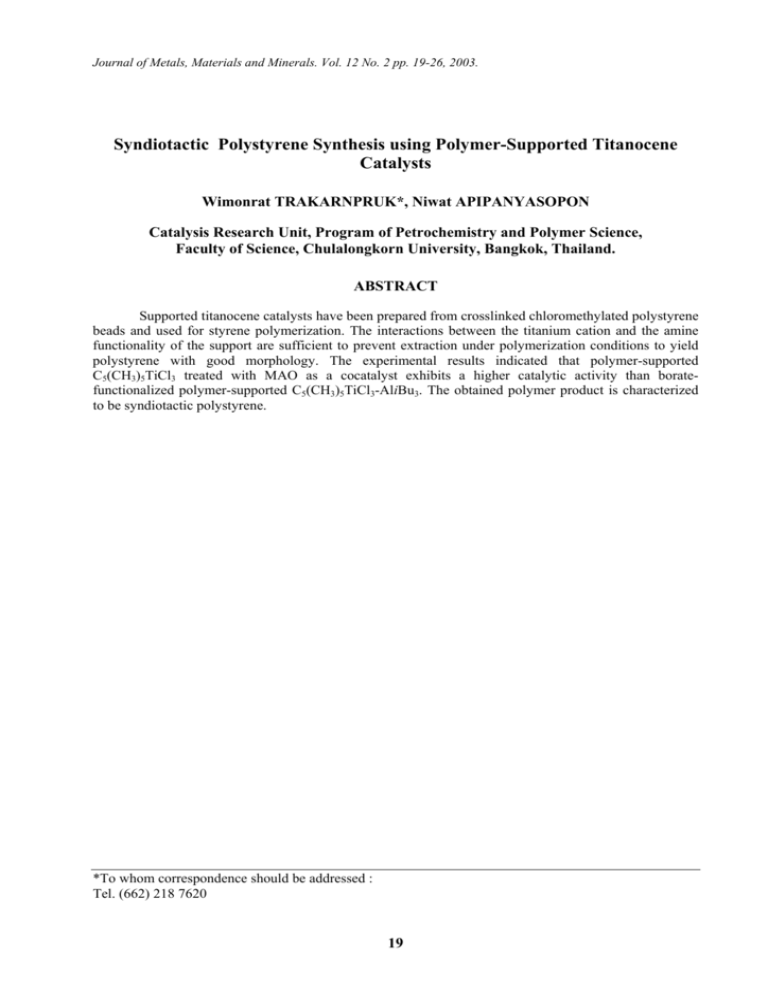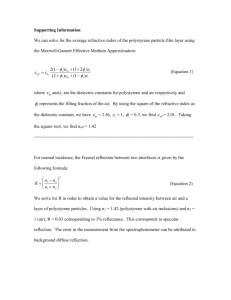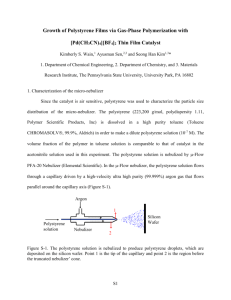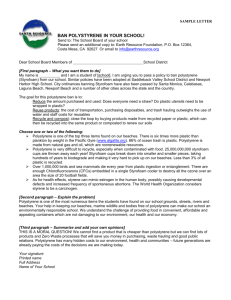Syndiotactic Polystyrene Synthesis using Polymer
advertisement

Journal of Metals, Materials and Minerals. Vol. 12 No. 2 pp. 19-26, 2003. Syndiotactic Polystyrene Synthesis using Polymer-Supported Titanocene Catalysts Wimonrat TRAKARNPRUK*, Niwat APIPANYASOPON Catalysis Research Unit, Program of Petrochemistry and Polymer Science, Faculty of Science, Chulalongkorn University, Bangkok, Thailand. ABSTRACT Supported titanocene catalysts have been prepared from crosslinked chloromethylated polystyrene beads and used for styrene polymerization. The interactions between the titanium cation and the amine functionality of the support are sufficient to prevent extraction under polymerization conditions to yield polystyrene with good morphology. The experimental results indicated that polymer-supported C5(CH3)5TiCl3 treated with MAO as a cocatalyst exhibits a higher catalytic activity than boratefunctionalized polymer-supported C5(CH3)5TiCl3-AliBu3. The obtained polymer product is characterized to be syndiotactic polystyrene. *To whom correspondence should be addressed : Tel. (662) 218 7620 19 20 TRAKARNPRUK, W. and APIPANYASOPON, N. INTRODUCTION Syndiotactic polystyrene is a new polymeric material of industrial relevance (Ishihara, et al. 1988). The high crystallization rate and the high melting point (270°C), make this polymer a crystalline engineering thermoplastic material with potential applications. It was first made by Ishihara (1986) using a soluble titanocene compound, activated by methylalumoxane (MAO) (Ishihara, et al. 1986). To replace the conventional Ziegler-Natta catalysts used in industrial slurry and gas-phase processes with titanocene catalyst, the soluble catalyst has to be immobilized on supports. The supported catalysts can overcome some disadvantages of homogeneous catalysts, such as poor polymer morphology, reaction fouling, and low bulk density of polymer. Inorganic supports, such as silica or alumina, have been used in the production of polyolefins, but such acidic supports have reactive surfaces that can lead to catalyst deactivation. Crosslinked polystyrene beads possess several attributes of a good support. They are unreactive to the catalyst, commercially available and amenable to numerous functionalization procedures. Crosslinked polystyrenes were used to coordinate with titanium catalysts for styrene polymerization, Yu, et al. (1996) with zirconium catalysts for ethylene polymerization, Hong, et al. (1998) and with hafnium catalysts for ethylene and propylene polymerizations (Kishi, et al. 2000). In this work, functionalized polystyrenesupported titanocene catalysts have been prepared and used for the styrene polymerization. EXPERIMENTAL Materials All manipulations of air- and moisturesensitive materials were performed with the Schlenk technique. Solvents were purified by refluxing over sodium/benzophenone ketyl under nitrogen. Chloromethylated polystyrene-codivinylbenzene beads (2%DVB, 4.3 mmol Cl/g resin) were purchased from Fluka. Styrene was dried over calcium hydride and distilled under vacuum. C5(CH3)5TiCl3 (or Cp*TiCl3), C5H5TiCl3 (or CpTiCl3), AliBu3 (or TIBA) and methylaluminoxane (or MAO) were donated from the Japan Advanced Institute of Science and Technology (JAIST), Japan; and [PhNMe2H][B(C6F5)4] was donated from the Dow Chemical Company, USA. Analytical Methods 13 C-NMR spectra were recorded on JEOL JNM-A500 at the Chemical Resources Laboratory, Tokyo Institute of Technology, Japan. A Nicolet FT-IR Impact 410 Spectrometer at the Chemistry Department, Chulalongkorn University, was employed to characterize samples by pressing with KBr. The melting temperature of the polystyrene was determined by a NETZSCH DSC 200 at the Scientific and Technological Research Equipment Center (STREC), Chulalongkorn University. The analyses were performed at a heating rate of 10°C/min, in the temperature range of 25°-300°C. The second scan was recorded because the first scan was influenced by the mechanical and thermal history of the samples. The molecular weight and the molecular weight distribution of the produced polystyrene were measured at 135°C using 1,2,4trichlorobenzene as solvent at 1.0 ml/min by a Water 150-C column using standard polystyrene as the reference, at the Chemical Resources Laboratory, Tokyo Institute of Technology, Japan. The morphology of the polymer beads were recorded on a JEOL JSM-5800 LV at the Scientific and Technological Research Equipment Center (STREC), Chulalongkorn University. The syndiotacticity content of polystyrene was determined by extracting the polymer in a Soxhlet extractor with methyl ethyl ketone. The fraction of the unextracted polystyrene multiplied by 100 was a percentage of the syndiotacticity. Preparation of functionalized (Roscoe, et al. 2000) polymer Synthesis of PS-CH2NMe2 (a), step 1 In a 100 mL Schlenk flask with a magnetic stirring bar, chloromethylated polystyrene-co-DVB beads (0.56 g) were swollen in a 2 M solution of dimethylamine in THF (5 mL, 10 mmol) and stirred for 2 days at room temperature. The aminated beads (a) were filtered and rinsed with THF and water and then dried under vacuum at 60°C. A complete reaction was demonstrated by the loss of the PhCH2Cl bending vibration at 1265 cm-1 and the appearance of new 21 Syndiotactic Polystyrene Synthesis using Polymer-Supported Titanocene Catalysts bands at 1255 (PhCH2NR2), 2817 and 2765 cm-1 [N(CH3)2 stretch] in the IR spectrum. Preparation of polymer-supported catalyst using boron as a cocatalyst Synthesis of PS-CH2[NMe2H][B(C6F5)4](b), step 2 PS-CH2NMe2[B(C6F5)4][C5(CH3)5TiBu2](c),step 3 The aminated beads (a) were then treated with a solution of [PhNMe2H][B(C6F5)4] (0.58 g, 0.78 mmol) in dichloromethane for 2 h and then filtered, followed by rinsing with dichloromethane and drying in vacuum at 60°C to give a functionalized polymer (b). The N(CH3)2 stretches diminish and are replaced by a band at 3303 (NH stretch), and bands of perfluorophenylborate at 1644, 1516, 1086 and 973 cm-1 in the IR spectrum. First, a toluene mixture of C5(CH3)5TiCl3 (0.1 mmol) and AliBu3 (0.1 mmol) was prepared (to convert a chloride complex to an alkyl complex). Then it was added to the 0.07 g borated functionalized beads (b). The mixture was stirred for 1 h at room temperature and then the beads (c) were filtered, rinsed with toluene and dried under vacuum. ( ) x ( ) 1-x ( Procedures of steps 1, 2 and 3 are shown in Figure 1. ) x ( ) 1-x HNMe2 step 1 NMe2 Cl step 2 ( ) x ( ) ( 1-x Cp*TiCl3 + [PhNMe2H][B(C6F5)4] ) x ( ) 1-x TIBA step 3 NMe2 [NMe2H][B(C6F5)4] i [Cp*Ti Bu2][B(C6F5)4] Figure 1 Synthetic procedure of borate-supported catalyst. Preparation of a polymer-supported catalyst using MAO as a cocatalyst Method A The procedure in step 1 is the same as above. In step 2, MAO (3 mmol) was added to 0.1 g aminated beads (a) which was swollen in toluene 20 mL. The mixture was stirred for 4 h at room temperature. The beads were filtered and rinsed with toluene. In step 3, a solution of C5H5TiCl3 (0.1 mmol) was added to the treated beads, and stirred for 24 h at 50°C, then the supported catalyst was filtered and washed with toluene. The synthetic procedure of MAO- supported catalyst is shown in Figure 2. 22 TRAKARNPRUK, W. and APIPANYASOPON, N. ( ) 1-x )x ( ( ) 1-x )x ( HNMe2 step 1 NMe2 Cl step 2 ) 1-x )x ( ( ( ) x MAO ) 1-x ( CpTiCl3 step 3 O NMe2 Al Al NMe2 TiCpCl3 O Me O Al O Al Al Al Me Figure 2 Synthetic procedure of MAO-supported catalyst. washed with toluene. In step 2, the procedure is the same as the step 3 of method A. The synthetic procedure of MAO directly treated-supported catalyst is shown in Figure 3. In addition, the same procedure was repeated, but C5H5TiCl3 was replaced with C5(CH3)5TiCl3. Method B In step 1, chloromethylated polystyrene-codivinylbenzene beads (0.1 g) were swollen in toluene (20 mL) and stirred for 15 min at room temperature and then MAO (3 mmol) was added and stirred for 4 h. The beads were filtered and ( )x ( ) 1-x ( ) 1-x )x ( MAO step 1 Cl Cl A Me B step 2 ( )x ( O Al O Al Al CpTiCl3 ) 1-x O Cl Al Me Al TiCpCl3 O Al Figure 3 Synthetic procedure of MAO directly treated-supported catalyst. 23 Syndiotactic Polystyrene Synthesis using Polymer-Supported Titanocene Catalysts Polymerization procedure In a nitrogen atmosphere, 10 mL of styrene (9.06 g, 87 mmol) was added into a Schlenk flask, followed by AliBu3 (20 mmol). The polymer-supported catalyst (0.1 g) was then introduced and the reaction mixture was stirred for 4 h. at 70°C. The polymerization was terminated by the addition of 10% HCl in methanol. The polymer was collected by filtration, washed with methanol and dried at 60°C in a vacuum oven until resulting constant weight. Each polymerization was repeated at least twice to ensure the reproducibility. In some experiments, MAO (3 mmol) was added instead of AliBu3. The obtained polymers were characterized by NMR, DSC and GPC techniques. RESULTS AND DISCUSSION Polymer-supported catalyst preparation A straightforward method for functionalizing a polystyrene support with the appropiate cocatalyst is to treat commercially available chloromethylated polystyrene-codivinylbenzene with a secondary amine to form a weakly basic anion exchange resin. The treatment of the amine-functionalized polymer with [PhNMe2H][B(C6F5)4] transfers a proton to the amine on the resin. The prepared resin was characterized by FTIR (Figure 4), the result is in good agreement with that from the literature (Roscoe, et al. 2000). The active catalysts are then generated in situ by the treatment of the borated beads with a mixture of C5(CH3)5TiCl3 and AliBu3. Figure 4 FTIR spectra of prepared resin. PS-CH2NMe2 (a) (above), PS-CH2[NMe2H][B(C6F5)4] (b) (below). Styrene polymerization The polymerizations were performed using different catalysts, the results are summarized in Table 1. The resulting polystyrene was extracted with boiling methyl ethyl ketone to yield % weight of insoluble part, which was calculated as %SPS. The syndiotacticity of the polystyrene was also confirmed from the 13 C NMR spectrum. The melting point of the polymer as measured by DSC is consistent with the syndiotactic polystyrene. The molecular weights were determined with GPC, the results are shown in Table 2. Table 1 The results of styrene polymerization with supported catalysts. Entry Catalyst Yield (g) % Conversion % SPS Tm (°C) 1 P-Cp*TiCl3 + TIBA 0.51 6 83 250 2 P-Cp*TiCl3 + TIBAa 0.50 6 81 250 P-Cp*TiCl3 + 7.68 85 98 MAO(Method B) P-CpTiCl3 + MAO 4 1.48 16 96 (Method A) P-CpTiCl3 + MAO 5 3.95 44 96 (Method B) Polymerization conditions: Catalyst bead 0.1 g, Ti loading = 0.1 mmol, styrene 10 mL, reaction time = 4 h, temperature = 70°C a The result from test of titanium leaching, by stirring the catalyst in toluene for 24 h before use in polymerization. ND = not determined 3 270 268 ND 24 TRAKARNPRUK, W. and APIPANYASOPON, N. Table 2 Molecular weights and weight distribution (MWD) of polystyrene. Catalyst P-Cp*TiCl3 + MAO Mw 40,304 Mn 17,098 MWD (Mw/Mn) 2.3 P-CpTiCl3 + MAO 190,349 52,564 3.6 In Table 2, the molecular weight of the polystyrene obtained from the P-Cp*TiCl3 catalytic system is lower than that from P-CpTiCl3, this result suggests that for a polymer supported catalyst system, steric effects disturb the propagation step of the polymer, it should be noted that for a homogeneous system, the reverse was observed since the electronic effect plays a more important role (Yokota, et al. 1999). A representative 13C NMR spectra of the obtained polystyrene synthesized by P-Cp*TiCl3 + MAO and P-CpTiCl3 + MAO are presented in Figure 5. The phenyl C1 carbon can provide the best guide to determine the stereoregularity of polystyrene (Ishihra, et al. 1988). The spectrum shows C1 carbon resonance at 145 ppm. It should be noted that the spectrum of atactic polystyrene shows five peaks at 145-146 ppm, while the 45.3 41.5 74.4 127.5 128.3 145.7 133.2 isodiotactic polystyrene shows a single peak at 146 ppm (Figure 6). 44.6 41.4 74.4 126.0 128.3 133.2 (1) 145.8 In Table 1, comparing entries 1 and 2, the result from the test of titanium leaching shows that the metal was not washed out by solvent (toluene) indicating that it is chemically bonded to the polymer support. In entry 3, using MAO as a cocatalyst instead of TIBA, the % conversion is higher. This result is in agreement with those in other catalytic systems that MAO is a more efficient cocatalyst (Alt and Koppl, 2000). Comparing titanium complexes: % conversion of Cp*TiCl3 is higher than that of CpTiCl3, this demonstrates that the active sites are stabilized by electron releasing methyl substituents on the Cp ring (Alt and Koppl, 2000). The results from entries 4 and 5 show that catalyst prepared with method B (direct treatment of polymer support with MAO) exhibits a higher activity than catalyst prepared with method A (treatment of the aminated polymer support with MAO). This might result from the more electron deficient Al (coordinated to Cl), which in turn abstracts halide from metal complexes to generate cation active species. All catalysts give high % syndiotacticity. The melting point of the polystyrene obtained confirms that it is syndiotactic polystyrene (Xu, et al. 2000). (2) 13 Figure 5 C-NMR spectra of the obtained polystyrene synthesized by (1) P-Cp*TiCl3 + MAO (2) P-CpTiCl3 + MAO Figure 6 13C-NMR spectra (expanded phenyl C1 region) of polystyrene (1) atactic (2) isotactic (3) syndiotactic 25 Syndiotactic Polystyrene Synthesis using Polymer-Supported Titanocene Catalysts It is well known that the morphology of the product polymer frequently mirrors that of the catalyst particle in heterogeneous (silica support) Ziegler-Natta polymerizations (Tait and Ediati, 1997). A similar behavior was observed for the catalysts supported on polymer (Kishi, et al. 2000). SEM micrographs in Figure 7 show the morphology of polystyrene synthesized from the supported catalyst system and homogeneous system. It can be seen that the supported catalyst gives polymers with a good morphology. a scavenger of impurity. The precatalyst C5(CH3)5TiCl3 shows a higher activity than C5H5TiCl3. Treatment of the polymer support with MAO directly can give a better catalyst. The structure of the polystyrene was characterized by NMR, the melting temperature that was determined from DSC reveals the syndiotactic character of the polymer. The spherical morphology of the obtained polystyrene, for which the polymer support catalyst acts as a shape template, is important for industrial operation. ACKNOWLEDGMENTS (a) The authors wish to thank Assoc. Prof. Dr. Takeshi Shiono, Tokyo Institute of Technology for NMR and GPC measurements, Dr. Toshiya Uozumi, Japan Advanced Institute of Science and Technology, Japan, Dr. David Wilson, Dow Chemical Company, USA., for chemical supplies. REFERENCES Alt, G., Koppl, A. 2000. Effect of the nature of metallocene complexes of group IV metals on their performance in catalytic ethylene and propylene polymerization. Chem. Rev. 100 : 1205-1221. (b) Figure 7 SEM micrographs of polystyrene synthesized from (a) homogeneous catalyst (b) suppported catalyst. CONCLUSIONS The method in this work is the phase immobilization of the active cationic titanocene site on noninteracting polystyrene. Polymersupported catalysts for the polymerization of styrene were prepared by treating cross-linked, chloromethylated polystyrene beads with secondary amine, a weakly coordinating anion (boron or aluminium compound), and finally a titanocene. In the case of using boron cocatalyst, AliBu3 was used as an alkylating agent as well as Hong, S. C., Ban, H.; Kishi, N., Jin, J., Uozumi, T. and Soga, K. 1998. Ethene polymerization with a poly(styrene-codivinylbenzene) beads supported racPh2Si(Ind)2ZrCl2 catalyst. Macromol. Chem. Phys. 199 : 1393-1397. Ishihara, N., Kuramoto, M. and Uoi, M. 1988. Stereospecific polymerization of styrene giving the syndiotactic polymer. Macromolecules. 21 : 3356-3360. Ishihara, N., Seimiya, T., Kuramoto, M. and Uoi, M. 1986. Crystalline syndiotactic polystyrene. Macromolecules. 19 : 24642465. Kishi, N., Ahn, C-H., Jin, J., Uozumi, T., Sano, T. and Soga, K. 2000. Synthesis of polymer supported borate cocatalysts and their application to metallocene polymerizations. Polymer. 41 : 40054012. 26 TRAKARNPRUK, W. and APIPANYASOPON, N. Roscoe, B., Gong, C., Frechet, J., Walzer, F. 2000. Functionalized polystyrene as a versatile support for olefin polymerization catalysts. J. Polym. Sci. Part A : Polym. Chem. 38 : 2979-2992. Tait, P. and Ediati, R. 1997. Propylene polymerization studies using supported metallocene catalysts. MetCon 97: Polymers in transition. Houston, TX, USA : 145-169. Xu, J., Ouyang, J., Fan, Z., Chen, D. and Feng, L. 2000. Polymer-Supported Half-Titanocene Catalysts for the Syndiotactic Polymerization of Styrene. J. Polym. Sci. Part A : Polym. Chem. 38 : 127-135. (Revised version accepted March 17, 2003) Yokota, K., Inoue, T., Naganuma, S., Shozaki, H., Tomotsu, N., Kuramoto, M. and Ishihara, N. 1999. Syndiospecific polymerization of styrene. In : Kaminsky, W. (ed) Metalorganic catalysts for synthesis and polymerization. Berlin, Springer-Verlag : 435-445. Yu, G., Chen, H., Zhang, X., Jiang, Z. and Huang, B. 1996. Polymer-supported titanium catalysts for syndiotactic polymerization of styrene. J. Polym. Sci. Part A : Polym. Chem. 34 : 2237-2241.







